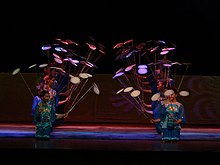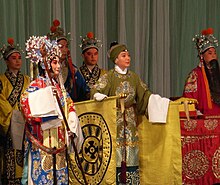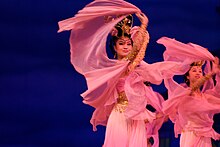Arts of China

The arts of China (simplified Chinese: 中国艺术; traditional Chinese: 中國藝術) have varied throughout its ancient history, divided into periods by the ruling dynasties of China and changing technology, but still containing a high degree of continuity. Different forms of art have been influenced by great philosophers, teachers, religious figures and even political leaders. The arrival of Buddhism and modern Western influence produced especially large changes. Chinese art encompasses fine arts, folk arts and performance arts.
General history



Early forms of art in China were made from pottery and jade in the Neolithic period, to which was added bronze in the Shang dynasty. The Shang are most remembered for their blue casting, noted for its clarity of detail. Early Chinese music and poetry was influenced by the Classic of Poetry, Confucius and the Chinese poet and statesman Qu Yuan.
In early imperial China,
Buddhist architecture and sculpture thrived in the
Categories




Chinese Blue and White Porcelain
Chinese Blue and White has been a major auction type in Western fine arts auction events. Sotheby's and Christie's act as major platforms for art collectors to trade collections. As of 2016, Chinese Blue and White porcelain antiques are traded for millions of US Dollars through these platforms.[1]
Literature
Early Chinese poetry
In addition to the Book of Songs (Shi Jing), a second early and influential poetic anthology was the Songs of Chu (simplified Chinese: 楚辞; traditional Chinese: 楚辭; pinyin: Chǔ Cí), made up primarily of poems ascribed to the semilegendary Qu Yuan (c. 340–278 BC) and his follower Song Yu (fourth century BC). The songs in this collection are more lyrical and romantic and represent a different tradition from the earlier Classic of Poetry (Shi Jing). Many of the works in the text are associated with Shamanism. There are also descriptions of fantastic landscapes, examples of China's first nature poetry. The longest poem, "Encountering Sorrow," is reputed to have been written by the tragic Qu Yuan as a political allegory.
Han and Northern dynasties poetry
During, the Han dynasty, Chu lyrics evolved into the
In the
Cao Zhi demonstrated his spontaneous wit at an early age and was a front-running candidate for the throne; however, such ability was devoted to Chinese literature and poetry, which was encouraged by his father's subordinate officials. Later he surrounded himself with a group of poets and officials with literary interests, including some who continually showed off their smartness at the expense of Cao Cao and Cao Pi's subordinates and even Cao Cao himself.
Tao Qian's poetry influenced the work of many subsequent poets. Approximately 120 of his poems survive, which depict an idyllic pastoral life of farming and drinking.
Golden age of Chinese poetry
The lines are of uneven length, though five
From the 2nd century AD, the yuefu began to develop into
The term gushi ("old poems") can refer either to the first, mostly anonymous shi poems, or more generally to the poems written in the same form by later poets. Gushi in this latter sense are defined essentially by what they are not; that is, they are not jintishi (regulated verse). The writer of gushi was under no formal constraints other than line length and rhyme (in every second line).
Jintishi, or
Notable poets from this era include
.Li Bai and Du Fu
Li Bai and Du Fu both lived during the Tang dynasty. They are regarded by many as the greatest of the Chinese poets.

Over a thousand poems are attributed to Li Bai, but the authenticity of many of these is uncertain. He is best known for his
Much like Mozart, many legends exist on how Li Bai effortlessly composed his poetry, even (or some say, especially) when drunk; his favorite form is the jueju (five- or seven-character quatrain), of which he composed some 160 pieces. Using striking, unconventional imagery, Li Bai is able to create exquisite pieces to utilize fully the elements of the language. His use of language is not as erudite as Du Fu's but equally effective, impressing through an extravagance of imagination and a direct connection of a free-spirited persona with the reader. Li Bai's interactions with nature, friendship, and his acute observations of life inform his best poems. Some of the rest, like Changgan xing (translated by Ezra Pound as A River Merchant's Wife: A Letter), records the hardships or emotions of common people. Like the best Chinese poets, Li Bai often evades translation.
Since the
One of the Du Fu's earliest surviving works, The Song of the Wagons (c. 750), gives voice to the sufferings of a conscript soldier in the imperial army, even before the beginning of the rebellion; this poem brings out the tension between the need of acceptance and fulfillment of one's duties, and a clear-sighted consciousness of the suffering which this can involve.
Du Fu's work is notable above all for its range. He mastered all the forms of

Late Tang and Five Dynasties poetry
Li Shangyin was a Chinese poet of the late Tang dynasty. He was a typical Late Tang poet: his works are sensuous, dense and allusive. The latter quality makes adequate translation extremely difficult. Many of his poems have political, romantic or philosophical implications, but it is often unclear which of these should be read into each work.
Li Yu developed the ci by broadening its scope from love to history and philosophy, particularly in his later works. He also introduced the two-
Song poetry
Ming literature
The Ming dynasty author Gao Qi is acknowledged as a great practitioner of poetry during the Ming dynasty. His poems are departure of those of earlier dynasties and formed a new style of poetry in the Ming dynasty. Zhang Dai is acknowledged as the greatest essayist of the Ming dynasty. Wen Zhenheng, the great-grandson of Wen Zhengming, wrote a classic on garden architecture and interior design, Zhang Wu Zhi (On Superfluous Things).
Qing literature
Yuan Mei was a well-known poet who lived during the Qing dynasty. In the decades before his death, Yuan Mei produced a large body of poetry, essays and paintings. His works reflected his interest in Chan Buddhism and the supernatural, at the expense of Taoism and institutional Buddhism—both of which he rejected. Yuan is most famous for his poetry, which has been described as "unusually clear and elegant language". His views on poetry as expressed in the Suiyuan shihua (隨園詩話) stressed the importance of personal feeling and technical perfection.
Many great works of art and literature originated during the period, and the Qianlong emperor in particular undertook huge projects to preserve important cultural texts. The novel form became widely read and perhaps China's most famous novel, Dream of the Red Chamber, was written in the mid-eighteenth century.
Western influence: the Big Three
In the early 20th century Shanghai became the birthplace and entertainment hub of the three new major art forms,
The most popular form of comics
Chinese popular music musicians like
Modern poetry
Modern Chinese poems (新詩 vers libre) usually do not follow any prescribed pattern.
Xu Zhimo is a romantic poet who loved the poetry of the English Romantics like Keats and Shelley. He was one of the first Chinese writers to successfully naturalize Western romantic forms into modern Chinese poetry.
Music
Early Chinese music
The origins of
Early Chinese music was based on percussion instruments such as the bronze bell. Chinese bells were sounded by being struck from the outside, usually with a piece of wood. Sets of bells were suspended on wooden racks. Inside excavated bells are groves and marks of scraping and scratching made as they were tuned to the right pitch. Percussion instruments gradually gave way to string and reed instruments toward the Warring States period.
Significantly, the character for writing the word music (yue) was the same as that for joy (le). For

Performing art
Yuan drama
" (丑, Clown), were introduced into the opera.
Cantonese opera, which originated from the north and developed over time since, contains many well-known programs such as The Purple Hairpin and Rejuvenation of the Red Plum Flower, originated from the Yuan dynasty.[dubious ][citation needed]
Peking opera

The best-known form of Chinese opera is Beijing or Peking opera, which assumed its present form in the mid-19th century and was extremely popular in the Qing dynasty (1644–1911). In Beijing Opera, traditional Chinese string and percussion instruments provide a strong rhythmic accompaniment to the acting. The acting is based on allusion: gestures, footwork, and other body movements express such actions as riding a horse, rowing a boat, or opening a door.
Although it is called Beijing opera, its origins are not in Beijing but in the Chinese provinces of

Dance
In ancient China. Chinese dance was divided into two types, civilian and military. In the Shang and Zhou period, civilian dance, dancers held feather banners in their hands, symbolizing the distribution of the fruits of the day's hunting or fishing.
The best known Chinese dances are the Dragon dance and the Lion dance.
Visual arts
Contemporary art
New forms of Chinese art were heavily influenced by the New Culture Movement, which adopted Western techniques and employed socialist realism. The Cultural Revolution would shape Chinese art in the 20th century like no other event in history with the Four Olds destruction campaign. Contemporary Chinese artists continue to produce a wide range of experimental works, multimedia installations, and performance "happenings" which have become very popular in the international art market.
Chinese paintings
-
Women striking and preparing silk, Song dynasty copy by Emperor Huizong of an earlier Tang dynasty painting by Zhang Xuan.
-
Buddhist Temple in the Mountains, 11th century, ink on silk, Nelson-Atkins Museum of Art, Kansas City (Missouri).
-
Details from "Night Revels of Han Xizai" by Gu Hongzhong
-
"Pigeon on a peach branch"; by Emperor Huizong of Song, Northern Song dynasty, 1108 or 1109 CE
-
Drunken Celestrial by Liang Kai
-
Imperial Hunting painted byGiuseppe Castiglione(1688–1766), Emperors' imperial palace Italian painter in Qing dynasty China.
Folk art

Han Paper art
The most notable invention of the Han period was paper which spawned two new types of arts.
See also
- Timeline of Chinese music
- History of Chinese Animations
- Classical Chinese poetry
- Culture of China
- Culture of Hong Kong
- Longmen Grottoes
References
- ^ Yi Ching, Leung. "2016 Top 20 Chinese porcelain auctions (Sotheby's/ Christie's)". zentopia-culture.com/. Leung Yi Ching. Archived from the original on 24 February 2019. Retrieved 15 January 2017.
- ^ Saussy, Haun. "Bei Dao and his Audiences". Lecture. Stanford University. Retrieved 13 August 2012.
- ^ "The Art of Chinese Dance". Cultural Division, Taipei Economic & Cultural Office in Houston. Archived from the original on 20 May 2017. Retrieved 27 September 2013.
- ISBN 0-8248-1800-8.
- ISBN 0-486-25837-8
Further reading
- Lee Yuan-Yuan and Shen, Sinyan. Chinese Musical Instruments (Chinese Music Monograph Series). 1999. Chinese Music Society of North America Press. ISBN 1-880464-03-9
- Shen, Sinyan. China: A Journey into Its Musical Art (Chinese Music Monograph Series). 2001. Chinese Music Society of North America Press. ISBN 1-880464-07-1
- Shen, Sinyan. Chinese Music in the 20th century (Chinese Music Monograph Series). 2001. Chinese Music Society of North America Press. ISBN 1-880464-04-7
- Watson, W., The Arts of China to AD 1900 (Yale University Press, 1995).
External links
- Chinese Art and Galleries at China Online Museum
- Famous Chinese Painters and their Galleries at China Online Museum
- Bibliography From the Herbert Offen Research Collection of the Phillips Library at the Peabody Essex Museum





